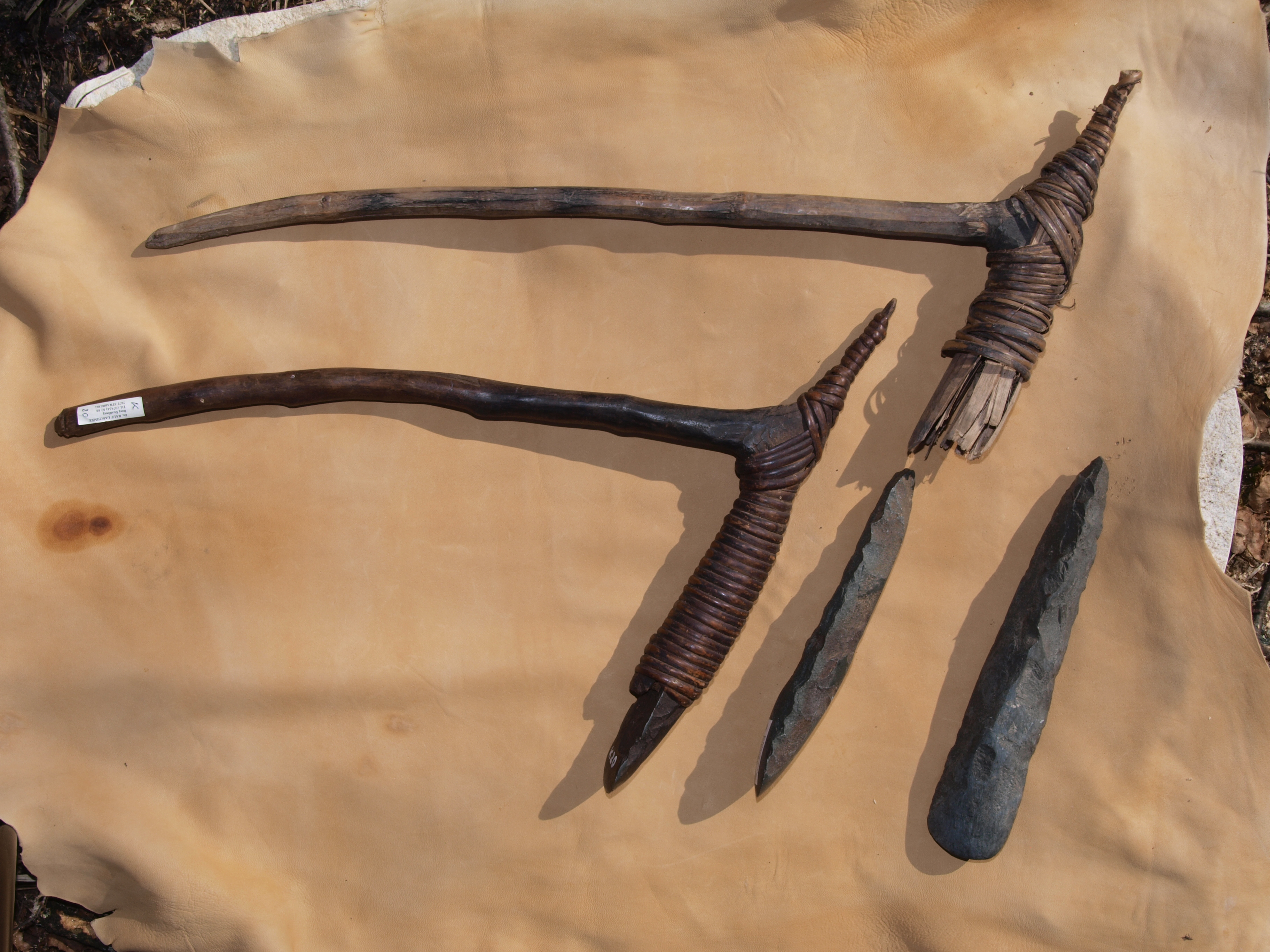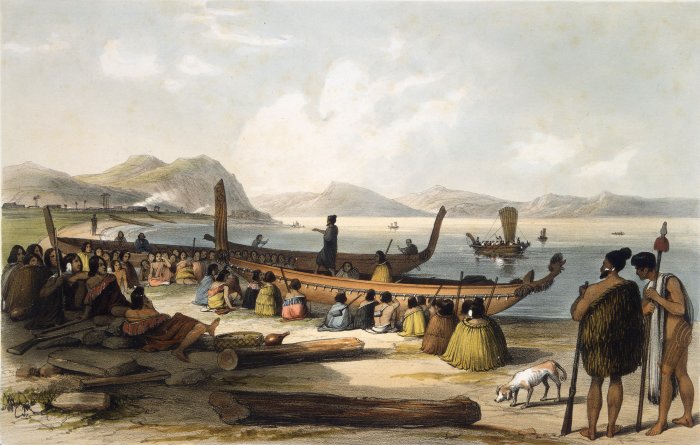|
Tainui (canoe)
''Tainui'' was one of the Māori migration canoes, great ocean-going canoes in which Polynesians migrated to New Zealand approximately 800 years ago. It was commanded by the chief Hoturoa, who had decided to leave Hawaiki because over-population had led to famine and warfare. The ship first reached New Zealand at Cape Runaway, Whangaparāoa in the Bay of Plenty and then skirted around the north coast of the North Island, finally landing at Kawhia in the western Waikato. The crew of the ''Tainui'' were the ancestors of the iwi that form the Tainui confederation. Crafting The Tainui waka (canoe), waka (canoe) was made from a great tree, at a place in Hawaiki known then as Maungaroa, on the spot where a stillborn child had been buried. According to Te Tāhuna Herangi the waka was named after the child who had been called Tainui. The canoe was made by Rakatāura, an expert boat builder in the tradition of Rātā (Māori mythology), Rātā, or according to Wirihana Aoterangi by R ... [...More Info...] [...Related Items...] OR: [Wikipedia] [Google] [Baidu] [Amazon] |
Rakatāura
Rakataura, also known as Hape or Rakatāura, is a legendary Polynesian navigator and a progenitor of many Māori iwi. Born in Hawaiki, Rakataura was the senior tohunga (priest/navigator) who led the ''Tainui'' migratory canoe to New Zealand. Rakataura is associated with stories involving the Manukau Harbour, the Te Tō Waka (the Ōtāhuhu Portage) and the Waikato. Many place names in Tāmaki Makaurau (modern-day Auckland) and the Waikato region reference Rakataura, or are described in oral traditions as being named by Rakataura. Oral history Rakataura was born in Hawaiki, and was the eldest member of the senior line of his hapū. He received the name Hape, due to his inward-turning feet. Rakataura was the senior tohunga (priest/navigator) of the ''Tainui'' migratory waka, and in some traditions, is identified as the shipbuilder of the vessel. In Waiohua oral tradition, Rakataura / Hape travels supernaturally to New Zealand, ahead of the ''Tainui'' crew. In this version, ... [...More Info...] [...Related Items...] OR: [Wikipedia] [Google] [Baidu] [Amazon] |
Hoturoa
According to Māori tradition, Hoturoa was the leader of the ''Tainui'' canoe, during the migration of the Māori people to New Zealand, around 1400. He is considered the founding ancestor of the Tainui confederation of tribes (iwi), who now inhabit the central North Island. Voyage to New Zealand According to Māori tradition, Hoturoa was a leader in Hawaiki, an unlocated territory somewhere in Polynesia. Because over-population had led to famine and warfare, Hoturoa decided to leave Hawaiki and he commissioned Rakatāura, an expert boat builder in the tradition of Rātā (or according to Wirihana Aoterangi by Rātā himself) to build the Tainui waka According to Pei Te Hurinui Jones the waka was named Tainui because when it first went into the water, it did not ride smoothly and one of Hoturoa's wives, perhaps Marama, shouted out "Hoturoa, your canoe is ('very heavy')". ''Tainui'' was one of the last waka to leave Hawaiki for New Zealand. It departed on Uenuku's night ... [...More Info...] [...Related Items...] OR: [Wikipedia] [Google] [Baidu] [Amazon] |
Tama-te-kapua
In Māori mythology, Māori tradition of New Zealand, Tama-te-kapua, also spelt Tamatekapua and Tama-te-Kapua and also known as Tama, was the captain of the ''Arawa (canoe), Arawa'' canoe which came to New Zealand from Polynesia in about 1350. A trickster, his theft of fruit from the orchard of the chieftain Uenuku escalated into a feud which forced him to leave the ancestral homeland of Hawaiki. On departure, he kidnapped Whakaotirangi, the wife of Ruaeo, and the priest Ngātoro-i-rangi. During the journey he was discovered sleeping with the wife of Ngātoro-i-rangi, who almost destroyed the canoe in revenge. When he arrived in New Zealand, he tricked the crew of the ''Tainui (canoe), Tainui'' into believing that he had arrived before them. He staked claims to Mount Moehau in the Coromandel Peninsula and to Maketu in the central Bay of Plenty, where he settled. Shortly after this, he was defeated by the vengeful Ruaeo and feuded with his son Kahumatamomoe, departing to Moehau, wh ... [...More Info...] [...Related Items...] OR: [Wikipedia] [Google] [Baidu] [Amazon] |
Arawa (canoe)
''Arawa'' was one of the great Māori migration canoes, ocean-going, voyaging canoes in Māori mythology, Māori traditions that was used in the migrations that settled New Zealand. The Te Arawa confederation of Māori people, Māori iwi and hapū based in the Rotorua Lakes, Rotorua and Bay of Plenty areas trace their ancestry from the people of this canoe. Background Te Arawa's ancestors on board the ''Arawa'' were of the Ngāti Ohomairangi of Raiatea, Ra'iātea Island. Following a battle that broke out between them and Uenuku, in which their own Whakatūria fell in battle, Tama-te-kapua promised to captain the voyage to the islands of New Zealand, which had been discovered by Ngahue, Ngāhue of the ''Tāwhirirangi'' canoe. Construction of the canoe A large tree was cut down by four men called Rata, Wahieroa, Ngāhue and Parata, to make the Waka (canoe), waka which came to be known as ''Arawa''. "Hauhau-te-rangi" and "Tūtauru" (made from New Zealand Pounamu, greenstone broug ... [...More Info...] [...Related Items...] OR: [Wikipedia] [Google] [Baidu] [Amazon] |
Pei Te Hurinui Jones
Pei Te Hurinui Jones (9 September 1898 – 7 May 1976) was a Māori political leader, writer, genealogist, and historian. As a leader of the Tainui tribal confederation and of the Māori King Movement, he participated in negotiations with the New Zealand Government, seeking compensation for land seizures, served on several boards, and authored a number of works in Māori and English, including the first history of the Tainui people. Early life Jones's mother was Pare Te Kōrae of the Ngāti Maniapoto tribe. His father, David Lewis, was a Pākehā storekeeper of Jewish descent at Poro-o-Tarāo, between Te Kūiti and Taumarunui. They had two sons, Michael Rotohiko Jones ('Mick'), born 1895, and Pei, who was born 9 September 1898 in Harataunga, on the Coromandel Peninsula. Lewis went to the Second Boer War and did not return to New Zealand afterwards. Pare Te Kōrae remarried to David Jones, of Ngā Puhi, and both sons adopted their step-father's surname. They moved to Te K ... [...More Info...] [...Related Items...] OR: [Wikipedia] [Google] [Baidu] [Amazon] |
Karakia
Karakia are Māori incantations and prayer used to invoke spiritual guidance and protection.Karakia , Otago University website. Retrieved 23 July 2019. They are also considered a formal greeting when beginning a . According to Māori legend, there was a curse on the Waiapu River which was lifted when George Gage (Hori Keeti) performed karakia. In |
Kumara (vegetable)
The sweet potato or sweetpotato (''Ipomoea batatas'') is a dicotyledonous plant in the morning glory family, Convolvulaceae. Its sizeable, starchy, sweet-tasting tuberous roots are used as a root vegetable, which is a staple food in parts of the world. Sweet potato cultivars, Cultivars of the sweet potato have been bred to bear tubers with flesh and skin of various colors. Moreover, the young shoots and leaves are occasionally eaten as Leaf vegetable, greens. The sweet potato and the potato are in the order Solanales, making them distant relatives. Although darker sweet potatoes are often known as "yams" in parts of North America, they are even more distant from actual yam (vegetable), yams, which are monocots in the order Dioscoreales. The sweet potato is Native species, native to the tropical regions of South America in what is present-day Ecuador. Of the approximately 50 Convolvulaceae#Genera, genera and more than 1,000 species of Convolvulaceae, ''I. batatas'' is the only cro ... [...More Info...] [...Related Items...] OR: [Wikipedia] [Google] [Baidu] [Amazon] |
Hakawai (mythology)
Hakawai, also Hōkioi in the North Island, was to the New Zealand Māori people, a mythology, mythological bird that was sometimes heard but not usually seen. It is now associated with the nocturnal aerial displays made by ''Coenocorypha'' snipe. Mythology In Māori mythology the Hakawai was one of eleven Tapu (Polynesian culture), tapu (sacred) birds of Raka-maomao, a god of wind. The Hakawai lived in the heavens and only descended to the earth at night. It was considered to be a gigantic bird of prey and was described (as the Hōkioi) by a Ngāti Apa chief, to the Governor of New Zealand Sir George Grey, as: Hearing the Hakawai was considered to be a bad omen, traditionally presaging war. Ornithology, Ornithologists in New Zealand have wondered whether the myth related to a real bird, whether extinct or still living, with some claiming that the myth was inspired by the now extinct Haast's eagle (''Hieraaetus moorei''). Although mention of the Hakawai occurred in Māori ... [...More Info...] [...Related Items...] OR: [Wikipedia] [Google] [Baidu] [Amazon] |
Adze
An adze () or adz is an ancient and versatile cutting tool similar to an axe but with the cutting edge perpendicular to the handle rather than parallel. Adzes have been used since the Stone Age. They are used for smoothing or carving wood in hand woodworking, and as a Hoe (tool), hoe for agriculture and horticulture. Two basic forms of an adze are the hand adze (short hoe)—a short-handled tool swung with one hand—and the foot adze (hoe)—a long-handled tool capable of powerful swings using both hands, the cutting edge usually striking at foot or shin level. A similar tool is called a mattock, which differs by having two blades, one perpendicular to the handle and one parallel. History Africa The adze is depicted in ancient Egyptian art from the Old Kingdom onward. Originally the adze blades were made of stone, but already in the Predynastic Egypt, Predynastic Period copper adzes had all but replaced those made of flint. Stone blades were fastened to the handle by tying ... [...More Info...] [...Related Items...] OR: [Wikipedia] [Google] [Baidu] [Amazon] |
Rātā (Māori Mythology)
In Māori mythology, accounts vary somewhat as to the ancestry of Rātā. Usually he is a grandson of Tāwhaki and son of Wahieroa. Wahieroa is treacherously killed by Matuku-tangotango, an ogre. Rātā sets out to avenge the murder, travelling to the home of Matuku, where a servant of the ogre tells him that Matuku comes out to devour people each new moon, and that he can be killed at the pool where he washes his face and hair. Rātā waits till the ogre comes out and is leaning over with his head in the pool. He grabs him by the hair and kills him. Matuku's bones are used to make spears for hunting birds. Rātā searches for his father's bones so that he can afford them the proper respect. He learns that the Ponaturi have the bones in their village. He must build a canoe to get there. He goes into the forest, and fells a tree, and cuts off the top. His day's work over, he goes home, and returns the next morning. To his surprise he finds the tree standing upright and whole. Once ... [...More Info...] [...Related Items...] OR: [Wikipedia] [Google] [Baidu] [Amazon] |
Waka (canoe)
Waka () are Māori people, Māori watercraft, usually canoes ranging in size from small, unornamented canoes (''waka tīwai'') used for fishing and river travel to large, decorated war canoes (''waka taua'') up to long. The earliest remains of a canoe in New Zealand were found near the Anaweka River, Anaweka estuary in a remote part of the Tasman District and Radiocarbon dating, radiocarbon-dated to about 1400. The canoe was constructed in New Zealand, but was a sophisticated canoe, compatible with the style of other Polynesian voyaging canoes at that time. Since the 1970s, about eight large double-hulled canoes of about 20 metres have been constructed for oceanic voyaging to other parts of the Pacific Ocean, Pacific. They are made of a blend of modern and traditional materials, incorporating features from ancient Melanesia, as well as Polynesia. Waka taua (war canoes) ''Waka taua'' (in Māori language, Māori, ''waka'' means "canoe" and ''taua'' means "army" or "war party") a ... [...More Info...] [...Related Items...] OR: [Wikipedia] [Google] [Baidu] [Amazon] |





